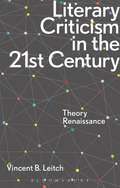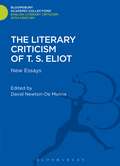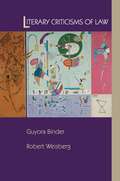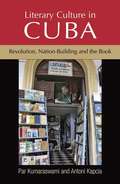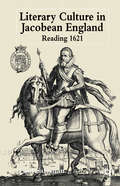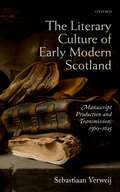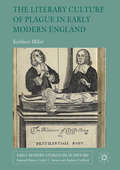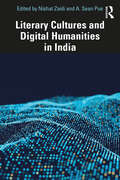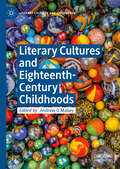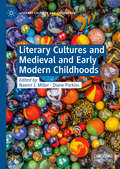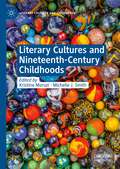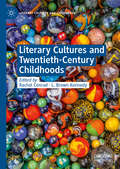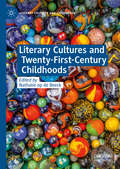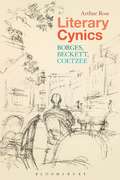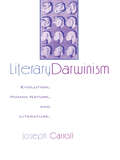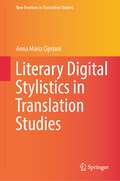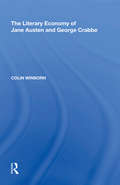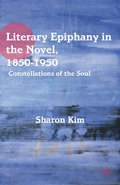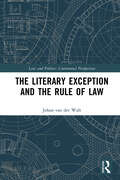- Table View
- List View
Literary Criticism in the 21st Century: Theory Renaissance
by Vincent B. LeitchFor more than a decade literary criticism has been thought to be in a post-theory age. Despite this, the work of thinkers such as Derrida, Deleuze and Foucault and new writers such as Agamben and Ranciere continue to be central to literary studies. Literary Criticism in the 21st Century explores the explosion of new theoretical approaches that has seen a renaissance in theory and its importance in the institutional settings of the humanities today. Literary Criticism in the 21st Century covers such issues as: The institutional history of theory in the academy The case against theory, from the 1970s to today Critical reading, theory and the wider world Keystone works in contemporary theory New directions and theory's many futures Written with an engagingly personal and accessible approach that brings theory vividly to life, this is a passionate defence of theory and its continuing relevance in the 21st century.
Literary Criticism of Matthew Arnold: Letters to Clough, the 1853 Preface and Some Essays
by Flemming OlsenMany of the ideas that appear in Arnold's Preface of 1853 to his collection of poems and in his later essays are suggested in the letters that Arnold wrote to his friend Arthur Hugh Clough. Analysis of the Preface reveals a poet who found a theoretical basis for poetry (by which he means literature in general) in the dramas of the Greek tragedians, particularly Sophocles: action is stressed as an indispensable ingredient, wholes are preferred to parts, the didactic function of literature is promoted -- in short, the Preface reads like the recipe for a classical tragedy. It is a young poet's attempt to establish criteria for what poetry ought to be. He found the Romantic idiom outworn. Literature was, in Arnold's perception, meant to communicate a message rather than impress by its structure or by formal sophistication. Modern theories of coalescence between content and form were outside the contemporary paradigm. T S Eliot's ambivalent attitude to Arnold -- now reluctantly admiring, now decidedly patronizing -- is puzzling. Eliot never seemed able to liberate himself from the influence of Arnold. What in Arnold's critical oeuvre attracted and at the same time repelled Eliot? That question has led to an in-depth analysis of Arnold as a literary critic. This book begins with an examination of Arnold's letters to Clough, where "it all started" and proceeds with a close reading of the 1853 Preface. A look at some of the later literary essays rounds off the picture of Arnold as a literary critic. This work is the result of Reader and Review comments of the author's well received Eliot's Objective Criticism: Tradition or Individual Talent? "Yet he is in some respects the most satisfactory man of letters of his age." -- T S Eliot, The Use of Poetry and the Use of Criticism.
The Literary Criticism of T.S. Eliot: New Essays (Bloomsbury Academic Collections: English Literary Criticism)
by David Newton-De MolinaIn his time T.S. Eliot established a new critical orthodoxy by which no major modern critic in England or America remained unaffected, but a decade has passed since his death and a generation or more since his extraordinary influence was at its height. It has therefore seemed worth attempting a fresh historical revaluation of Eliot's critical achievement and the nine distinguished scholars whom Dr Newton-De Molina approached responded readily to his invitation that they undertake such a project. Their essays range widely over the various aspects of Eliot's critical activity and place it in the context not only of his endeavours as poet and dramatist but also of his formal training as a philosopher and of his conversion to Christianity. They contrast the early and later work (not forgetting Eliot's own retrospective comments on the former), consider its relation to the English critical and poetic tradition, and seek to show in what ways criticism may derive new impetus from the example both of Eliot's strengths and of his limitations.
Literary Criticisms of Law
by Guyora Binder Robert WeisbergIn this book, the first to offer a comprehensive examination of the emerging study of law as literature, Guyora Binder and Robert Weisberg show that law is not only a scheme of social order, but also a process of creating meaning, and a crucial dimension of modern culture. They present lawyers as literary innovators, who creatively interpret legal authority, narrate disputed facts and hypothetical fictions, represent persons before the law, move audiences with artful rhetoric, and invent new legal forms and concepts. Binder and Weisberg explain the literary theories and methods increasingly applied to law, and they introduce and synthesize the work of over a hundred authors in the fields of law, literature, philosophy, and cultural studies. Drawing on these disparate bodies of scholarship, Binder and Weisberg analyze law as interpretation, narration, rhetoric, language, and culture, placing each of these approaches within the history of literary and legal thought. They sort the styles of analysis most likely to sharpen critical understanding from those that risk self-indulgent sentimentalism or sterile skepticism, and they endorse a broadly synthetic cultural criticism that views law as an arena for composing and contesting identity, status, and character. Such a cultural criticism would evaluate law not simply as a device for realizing rights and interests but also as the framework for a vibrant cultural life.
Literary Criticisms of Law
by Guyora Binder Robert WeisbergIn this book, the first to offer a comprehensive examination of the emerging study of law as literature, Guyora Binder and Robert Weisberg show that law is not only a scheme of social order, but also a process of creating meaning, and a crucial dimension of modern culture. They present lawyers as literary innovators, who creatively interpret legal authority, narrate disputed facts and hypothetical fictions, represent persons before the law, move audiences with artful rhetoric, and invent new legal forms and concepts. Binder and Weisberg explain the literary theories and methods increasingly applied to law, and they introduce and synthesize the work of over a hundred authors in the fields of law, literature, philosophy, and cultural studies. Drawing on these disparate bodies of scholarship, Binder and Weisberg analyze law as interpretation, narration, rhetoric, language, and culture, placing each of these approaches within the history of literary and legal thought. They sort the styles of analysis most likely to sharpen critical understanding from those that risk self-indulgent sentimentalism or sterile skepticism, and they endorse a broadly synthetic cultural criticism that views law as an arena for composing and contesting identity, status, and character. Such a cultural criticism would evaluate law not simply as a device for realizing rights and interests but also as the framework for a vibrant cultural life.
Literary culture in Cuba: Revolution, nation-building and the book
by Par Kumaraswami Antoni KapciaSpecialist researchers; academics in Cuban Studies/Latin American Studies/Cultural Studies; postgraduate students; undergraduate students (all years); enthusiasts.
Literary Culture in Jacobean England: Reading 1621
by P. SalzmanThis book offers an unparalleled depth of historical research by surveying the extraordinary richness of literary culture in a single year. Paul Salzman examines what is written, published, performed and, in some cases, even spoken during 1621 in Britain. Well-known works by writers such as Donne, Burton, Middleton, and Ralegh, are examined alongside hitherto unknown works in a huge variety of genres: plays, poems, romances, advice books, sermons, histories, parliamentary speeches, royal proclamations. This is a work of literary history that greatly enhances knowledge of what it was like to read, write and listen in early modern Britain.
The Literary Culture of Early Modern Scotland: Manuscript Production and Transmission, 1560-1625
by Sebastiaan VerweijThis study presents a history of the literary culture of early-modern Scotland (1560-1625), based on extensive study of the literary manuscript. It argues for the importance of three key places of production of such manuscripts: the royal court, burghs and towns, and regional houses (stately homes, but also minor lairdly and non-aristocratic households). This attention to place facilitates a discussion of, respectively, courtly, urban or civic, and regional literary cultures. Sebastiaan Verweij's methodology stems from bibliographical scholarship and the study of the 'History of the Book', and more specifically, from a school of manuscript research that has invigorated early-modern English literary criticism over the last few decades. The Literary Culture of Early Modern Scotland will also intersect with a programme of reassessment of early-modern Scottish culture that is currently underway in Scottish studies. Traditional narratives of literary history have often regarded the Reformation of 1560 as heralding a terminal cultural decline, and the Union of Crowns of 1603, with the departure of king and court, was thought to have brought the briefest of renaissances (in the 1580s and 1590s) to an early end. This book purposefully straddles the Union, in order to make possible the rediscovery of Scotland's refined and sophisticated renaissance culture.
The Literary Culture of Plague in Early Modern England (Early Modern Literature in History)
by Kathleen MillerThis book is about the literary culture that emerged during and in the aftermath of the Great Plague of London (1665). Textual transmission impacted upon and simultaneously was impacted by the events of the plague. This book examines the role of print and manuscript cultures on representations of the disease through micro-histories and case studies of writing from that time, interpreting the place of these media and the construction of authorship during the outbreak. The macabre history of plague in early modern England largely ended with the Great Plague of London, and the miscellany of plague writings that responded to the epidemic forms the subject of this book.
Literary Cultures and Digital Humanities in India
by Nishat Zaidi A. Sean PueThis book explores the use of digital humanities (DH) to understand, interpret, and annotate the poetics of Indian literary and cultural texts, which circulate in digital forms — in manuscripts — and as oral or musical performance. Drawing on the linguistic, cultural, historical, social, and geographic diversity of Indian texts and contexts, it foregrounds the use of digital technologies — including minimal computing, novel digital humanities research and teaching methodologies, critical archive generation and maintenance — for explicating poetics of Indian literatures and generating scholarly digital resources which will facilitate comparative readings. With contributions from DH scholars and practitioners from across India, the United States, the United Kingdom, and more, this book will be a key intervention for scholars and researchers of literature and literary theory, DH, media studies, and South Asian Studies.
Literary Cultures and Digital Humanities in India
by Nishat Zaidi A. Sean PueThis book explores the use of digital humanities (DH) to understand, interpret, and annotate the poetics of Indian literary and cultural texts, which circulate in digital forms — in manuscripts — and as oral or musical performance. Drawing on the linguistic, cultural, historical, social, and geographic diversity of Indian texts and contexts, it foregrounds the use of digital technologies — including minimal computing, novel digital humanities research and teaching methodologies, critical archive generation and maintenance — for explicating poetics of Indian literatures and generating scholarly digital resources which will facilitate comparative readings. With contributions from DH scholars and practitioners from across India, the United States, the United Kingdom, and more, this book will be a key intervention for scholars and researchers of literature and literary theory, DH, media studies, and South Asian Studies.
Literary Cultures and Eighteenth-Century Childhoods (Literary Cultures and Childhoods)
by Andrew O’MalleyThe essays in this volume offer fresh and innovative considerations both of how children interacted with the world of print, and of how childhood circulated in the literary cultures of the eighteenth century. They engage with not only the texts produced for the period’s newly established children’s book market, but also with the figure of the child as it was employed for a variety of purposes in literatures for adult readers. Embracing a wide range of methodological and disciplinary perspectives and considering a variety of contexts, these essays explore childhood as a trope that gained increasing cultural significance in the period, while also recognizing children as active agents in the worlds of familial and social interaction. Together, they demonstrate the varied experiences of the eighteenth-century child alongside the shifting, sometimes competing, meanings that attached themselves to childhood during a period in which it became the subject of intensified interest in literary culture.
Literary Cultures and Medieval and Early Modern Childhoods (Literary Cultures and Childhoods)
by Naomi J. Miller Diane PurkissBuilding on recent critical work, this volume offers a comprehensive consideration of the nature and forms of medieval and early modern childhoods, viewed through literary cultures. Its five groups of thematic essays range across a spectrum of disciplines, periods, and locations, from cultural anthropology and folklore to performance studies and the history of science, and from Anglo-Saxon burial sites to colonial America. Contributors include several renowned writers for children. The opening group of essays, Educating Children, explores what is perhaps the most powerful social engine for the shaping of a child. Performing Childhood addresses children at work and the role of play in the development of social imitation and learning. Literatures of Childhood examines texts written for children that reveal alternative conceptions of parent/child relations. In Legacies of Childhood, expressions of grief at the loss of a child offer a window into the family’s conceptions and values. Finally, Fictionalizing Literary Cultures for Children considers the real, material child versus the fantasy of the child as a subject.
Literary Cultures and Nineteenth-Century Childhoods (Literary Cultures and Childhoods)
by Kristine Moruzi Michelle J. SmithLiterary Cultures and Nineteenth-Century Childhoods explores the construction of the child and the development of texts for children in the nineteenth century through the application of fresh theoretical approaches and attention to aspects of literary childhoods that have only recently begun to be illuminated. This scope enables examination of the child in canonical nineteenth-century novels by Charles Dickens, Elizabeth Gaskell, Charlotte Bronte, and Thomas Hardy alongside well-known fiction intended for young readers by George MacDonald, Christabel Coleridge, and Kate Greenaway. The century was also distinctive for the rise of the children’s magazine, and this book broadens the definition of literary cultures to include magazines produced both by, and for, young people. The volume examines how the child and family are conceptualised, how children are positioned as readers in genres including the domestic novel, school story, Robinsonade, and fantasy fiction, how literary childhoods are written and politicised, and how childhood intersects with perceptions of animals and the natural environment. The range of chapters in this collection and the texts they consider demonstrates the variability and fluidity of literary cultures and nineteenth-century childhoods.
Literary Cultures and Twentieth-Century Childhoods (Literary Cultures and Childhoods)
by Rachel Conrad L. Brown KennedyThis collection of essays offers innovative methodological and disciplinary approaches to the intersection of Anglophone literary cultures with children and childhoods across the twentieth century. In two acts of re-centering, the volume focuses both on the multiplicity of childhoods and literary cultures and on child agency. Looking at classic texts for young audiences and at less widely-read and unpublished material (across genres including poetry, fiction, historical fiction or biography, picturebooks, and children’s television), essays foreground the representation of child voices and subjectivities within texts, explore challenges to received notions of childhood, and emphasize the role of child-oriented texts in larger cultural and political projects. Chapters frame themes of spectacle, self, and specularity across the twentieth-century; question tropes of childhood; explore identity and displacement in narrating history and culture; and elevate children as makers of literary culture. A major intent of the volume is to approach literary culture not just as produced by adults for consumption by children but also as co-created by young people through their actions as speakers, artists, readers, and writers.
Literary Cultures and Twenty-First-Century Childhoods (Literary Cultures and Childhoods)
by Nathalie op de BeeckIn the early decades of the twenty-first century, we are grappling with the legaciesof past centuries and their cascading effects upon children and all people. Werealize anew how imperialism, globalization, industrialization, and revolutioncontinue to reshape our world and that of new generations. At a volatile moment,this collection asks how twenty-first century literature and related mediarepresent and shape the contemporary child, childhood, and youth.Because literary representations construct ideal childhoods as well as model therights, privileges, and respect afforded to actual young people, this collectionsurveys examples from popular culture and from scholarly practice. Chaptersinvestigate the human rights of children in literature and international policy; thepotential subjective agency and power of the child; the role models proposed foryoung people; the diverse identities children embody and encounter; and theenvironmental well-being of future human and nonhuman generations.As a snapshot of our developing historical moment, this collection identifiesemergent trends, considers theories and critiques of childhood and literature,and observes how new technologies and paradigms are destabilizing pastconventions of storytelling and lived experience.
Literary Cynics: Borges, Beckett, Coetzee
by Arthur RoseFocusing on work by Jorge Luis Borges, Samuel Beckett and J.M. Coetzee, Literary Cynics explores the relationship between literature and cynicism to consider what happens when authors write themselves into their art, against the rhetoric of authority. Rose takes as his starting point three moments of aesthetic crisis in the careers of these literary cynics: Borges's parables of the 1950s, Beckett's plays of the 1980s, and Coetzee's pedagogic novels of the 2000s. In their transition to 'late style', the works reflect their writers' abiding concern with particular conceptions of rhetoric and aesthetic form. Literary Cynics combines accounts of these 'late' works with classic, lesser known, and archival texts by the three writers, from Coetzee's Disgrace to Beckett's letters, as well as detailed analysis of cynicism, both ancient and modern, as a philosophical and political movement.
Literary Cynics: Borges, Beckett, Coetzee
by Arthur RoseFocusing on work by Jorge Luis Borges, Samuel Beckett and J.M. Coetzee, Literary Cynics explores the relationship between literature and cynicism to consider what happens when authors write themselves into their art, against the rhetoric of authority. Rose takes as his starting point three moments of aesthetic crisis in the careers of these literary cynics: Borges's parables of the 1950s, Beckett's plays of the 1980s, and Coetzee's pedagogic novels of the 2000s. In their transition to 'late style', the works reflect their writers' abiding concern with particular conceptions of rhetoric and aesthetic form. Literary Cynics combines accounts of these 'late' works with classic, lesser known, and archival texts by the three writers, from Coetzee's Disgrace to Beckett's letters, as well as detailed analysis of cynicism, both ancient and modern, as a philosophical and political movement.
Literary Darwinism: Evolution, Human Nature, and Literature
by Joseph CarrollFirst published in 2004. Routledge is an imprint of Taylor & Francis, an informa company.
Literary Darwinism: Evolution, Human Nature, and Literature
by Joseph CarrollFirst published in 2004. Routledge is an imprint of Taylor & Francis, an informa company.
Literary Digital Stylistics in Translation Studies (New Frontiers in Translation Studies)
by Anna Maria CiprianiThis book presents a systematic literary comparison of the retranslations by adopting a mixed-method and bottom-up (inductive) approach by developing an empirical corpus approach. This corpus is specifically tailored to identify and study linguistic and non-linguistic modernist features throughout the texts, such as stream of consciousness-indirect interior monologue and free indirect speech. All occurrences are analysed quantitatively in the computations of inferential and comparative statistics, such as tests of time trends, lexical variety, and lexical frequency. The target texts are digitised, and the resulting text files are then analysed using a bespoke, novel computer program capable of the functions not provided by commercially available software such as WordSmith Tools and WMatrix. This methodology enables in-depth explorations of micro- and macro-textual features and allows a mixed-method approach combining close-reading qualitative analysis with systematic quantitative comparisons. The empirical study of the digital corpus of eleven Italian (re)translations of Virginia Woolf’s To the Lighthouse identifies a progressive source-text orientation only in a relatively few aspects of a few target texts. The translators’ presence affects all the examined target texts in terms of register and style under the influence of the Italian translation norms usually attributed to the translation of literary classics. Its intended readership comprises students of the mentioned fields and the general public of readers, editors, and publishers.
The Literary Economy of Jane Austen and George Crabbe
by Colin WinbornThough Jane Austen (1775-1817) and the poet George Crabbe (1754-1832) each wrote during the Napoleonic Wars, no full-length study has considered the importance of these pivotal events to their writing. In The Literary Economy of Jane Austen and George Crabbe, the author argues that both writers were unusually responsive to the economic anxieties specific to wartime, occasioned especially by the Napoleonic trade embargo imposed on Britain from 1806 to 1812, and shared a particular concern with the economizing of space. The author's term 'spatial economy' refers to the practice of turning available resources to the best possible account, which these authors applied even to the practice of writing as they strove to preserve space on the page (Austen in her letters and Crabbe in the couplet). Their work displays a preoccupation with boundaries, pressure, and containment, which also informs economic treatises published during this period. Through close readings and fresh contextual and historical analysis that draws on the ideas of contemporary thinkers such as Thomas Malthus, William Spence, William Cobbett, Arthur Young, and Humphrey Repton, Winborn not only establishes a close affinity between Austen and Crabbe but makes a convincing case for rethinking the relationship between the novel and poetry during the Romantic period.
The Literary Economy of Jane Austen and George Crabbe
by Colin WinbornThough Jane Austen (1775-1817) and the poet George Crabbe (1754-1832) each wrote during the Napoleonic Wars, no full-length study has considered the importance of these pivotal events to their writing. In The Literary Economy of Jane Austen and George Crabbe, the author argues that both writers were unusually responsive to the economic anxieties specific to wartime, occasioned especially by the Napoleonic trade embargo imposed on Britain from 1806 to 1812, and shared a particular concern with the economizing of space. The author's term 'spatial economy' refers to the practice of turning available resources to the best possible account, which these authors applied even to the practice of writing as they strove to preserve space on the page (Austen in her letters and Crabbe in the couplet). Their work displays a preoccupation with boundaries, pressure, and containment, which also informs economic treatises published during this period. Through close readings and fresh contextual and historical analysis that draws on the ideas of contemporary thinkers such as Thomas Malthus, William Spence, William Cobbett, Arthur Young, and Humphrey Repton, Winborn not only establishes a close affinity between Austen and Crabbe but makes a convincing case for rethinking the relationship between the novel and poetry during the Romantic period.
Literary Epiphany in the Novel, 1850–1950: Constellations of the Soul
by S. KimThis book studies literary epiphany as a modality of character in the British and American novel. Epiphany presents a significant alternative to traditional models of linking the eye, the mind, and subject formation, an alternative that consistently attracts the language of spirituality, even in anti-supernatural texts. This book analyzes how these epiphanies become "spiritual" and how both character and narrative shape themselves like constellations around such moments. This study begins with James Joyce, 'inventor' of literary epiphany, and Martin Heidegger, who used the ancient Greek concepts behind 'epiphaneia' to re-define the concept of Being. Kim then offers readings of novels by Susan Warner, George Eliot, Edith Wharton, Virginia Woolf, and William Faulkner, each addressing a different form of epiphany.
The Literary Exception and the Rule of Law (Law and Politics)
by Johan Van Der WaltAddressing the influential analysis of law and literature, this book offers a new perspective on their relationship. The law and literature movement that has gained global prominence in the course of last decades of the twentieth and the first decades of the twenty-first centuries has provided the research and teaching of law with a considerable body of new and valuable knowledge and understanding. Most of the knowledge and insights generated by the movement concern either a thematic overlap between legal and literary discourses – suggesting they deal with the same moral concerns – or a rhetorical, semiotic or general linguistic comparability or ‘sameness’ between them – imputing to both the same or very similar narrative structures. The Literary Exception and the Rule of Law recognises the wealth of knowledge generated by this approach to the relationship between law and literature, and acknowledges its debt to this genre of scholarship. It nevertheless also proposes, on the basis of a number of revealing phenomenological inquiries, a different approach to law and literary studies: one that emphasises the irreducible difference between law and literature. It does so with the firm believe that a regard for the very different and indeed opposite discursive trajectories of legal and literary language allows for a more profound understanding of the unique and indeed separate roles that the discourses of law and literature generally play in the sustenance of relatively stable legal cultures. This important rethinking of the relationship between law and literature will appeal to scholars and students of legal theory, jurisprudence, philosophy, politics and literary theory.
